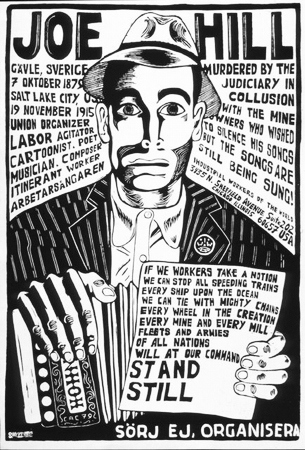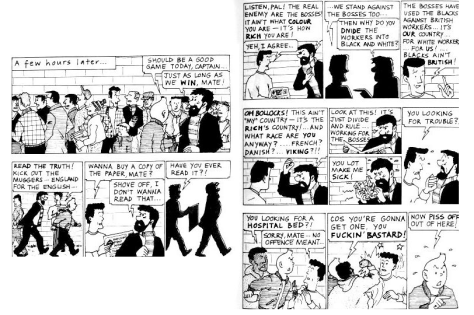Title: Wobblies! A Graphic History of the Industrial Workers of the World
Contributors: Mike Alewitz, Seth Tobocman, Sue Coe, Sabrina Jones
Edited: Paul Buhle and Nicole Schulman
Published: Verso Books, 2005
Length: 306 Pages
“Happy May Day, friends and fellow workers!”
It is hard to imagine these words would once have been enough to land the speaker in a cramped jail cell, crammed with dozens of fellow workers like so many salty, tinned fish. ‘Wobblies!’ chronicles the rise of the Industrial Workers of the World from a promising start in Chicago. We are taken through several major strikes and biographies of bohemians and revolutionaries by the comic’s several contributors. Curiously, what unites many of these tales is the suffering of their subjects.

Perhaps there is nothing surprising in this. There is a peculiar allure to martyrdom. Saints, mystics and secular heroes of humanity the world over have been canonized by their suffering long before any state or patriarch could place the laurels on their bloodied brows. Hagiography, the genre of saints’ biographies, owes much of its enduring popularity to stories of the suffering of those early Christians. In a modern context, today is a commemoration of the deaths of the Haymarket Martyrs, Chicago anarchists who went to the gallows for a crime none had committed. “Wobblies” continues in this tradition.

In its entirety, the book is a collection of short narratives surrounding major events in the history of the IWW. It begins with a detailed recounting of their founding convention, rich in historical personages such as perennial Socialist candidate Eugene V. Debs and Haymarket widow (and ass-kicking anarchist heroine) Lucy Parsons. From there, it outlines several major strikes, particularly those associated with the Western Federation of Miners, and the textile strikes in Lawrence and Paterson, a high watermark for union organizing under the IWW banner. This is followed by more strike accounts, then biographical sketches of the highly eclectic bunch of radicals who swelled the ranks of the IWW during its heyday and kept its memory alive through long decades of irrelevance. It ends with two modern episodes. The first details the life of environmentalist and Wobbly Judy Bari, while the second recounts a port strike in Jefferson, Indiana.

Nothing in this critique is meant to belittle the value of the struggles, or the bravery of participants. These are struggles that shaped the lives of generations of Americans by putting a pressure on state and capital alike. The fights found between these pages paved the way for the eight hour day, for wage increases and safety regulations. But they also fell short of the ultimate goal; a society in which the wealth of society is shared equally amongst those who produce it.
These vignettes are a mixture of victory, defeat and sentimental reminisce. Shot through all of them are scenes of agony, of sometimes lethal suffering. Martyrdom is an old and popular theme in heroic narrative, and echoes from Calvary to Tahrir. Looking at these graphic re-tellings, it is impossible not to be reminded of paintings of saints caged in cells, pierced by arrows. They are ennobled, it would seem, by their suffering.


So it is for the workers in the pages of “Wobblies!” They are shot, beaten, jailed, defamed, tortured, bombed, ridiculed and betrayed. The outcome of the struggle is secondary to these latter-day passion plays, showcasing the divine agony of the downtrodden. Anguish is often compounded by anguish, with strikers blamed for the deaths of other strikers.

There are courage and beauty both in the struggles of IWW organizers and members. Their suffering is a credit to their devotion. But it is their vision that matters most to the future, not their pain. They were not shot so our eyes could blear at the mention of their memory. Not for nothing are the words associated with Joe Hill: “Don’t mourn, organize!”
In other words, the image of Frank Little that captures our imagination is not his battered corpse hanging from a Montana Bridge, but of the cantankerous old bastard hobbling around America on two crutches. With one leg and one eye, Little walked farther and saw more in the name of industrial struggle than many activists could imagine today. As he is said to have remarked “All we’re gonna need from now on is guts!”
It is fitting, then, that the image of Judi Bari that concludes her story is not one of the car bomb that took her legs, but of Bari fiddling. It would be too easy to dwell on the pain of these Wobblies, to accept the tacit coupling of corporal agony and moral ecstasy. But on this May Day, and every day, we have to remember that this is not why blood was shed. This is not why bones were broken. Our antecedents suffered not so that we could romanticize them, but so that we could follow their lead. The general strike is our best hope, and it will take one big union to get there.











